 W
WActinidia kolomikta, the kolomikta, miyamatatabi, variegated-leaf hardy kiwi, is a species of flowering plant in the family Actinidiaceae, native to temperate mixed forests of the Russian Far East, Korea, Japan and China.
 W
WActinidia polygama is a species of kiwifruit in the Actinidiaceae family. It grows in the mountainous areas of Korea, Japan and China at elevations between 500 and 1,900 metres.
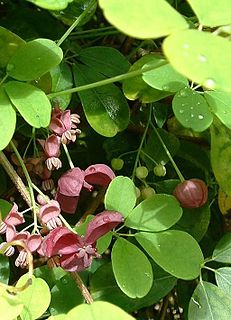 W
WAkebia quinata, commonly known as chocolate vine, five-leaf chocolate vine, or five-leaf akebia, is a shrub that is native to Japan, China and Korea, and invasive in the eastern United States from Georgia to Michigan to Massachusetts. In its native habitat, it is often found on hills, in hedges, on trees, along forest edges and streams, and on mountainous slopes.
 W
WAmanatsu (甘夏) or natsumikan is a yellowish orange citrus hybrid fruit, a group of cultivars of Citrus natsudaidai, which were discovered in 1740 in the Yamaguchi prefecture of Japan.
 W
WChaenomeles is a genus of three species of deciduous spiny shrubs, usually 1–3 m tall, in the family Rosaceae. They are native to Southeast Asia. These plants are related to the quince and the Chinese quince, differing in the serrated leaves that lack fuzz, and in the flowers, borne in clusters, having deciduous sepals and styles that are connate at the base.
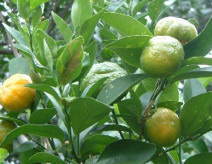 W
WCitrus depressa, in English sometimes called shiikuwasha, shequasar, Taiwan tangerine, Okinawa lime, flat lemon, hirami lemon, or thin-skinned flat lemon, is a small, green citrus fruit rich in flavonoids and native to East Asia.
 W
WCitrus unshiu is a semi-seedless and easy-peeling citrus species, also known as miyagawa mandrin, unshu mikan, cold hardy mandarin, satsuma mandarin, satsuma orange, naartjie, and tangerine. Citrus unshiu was named after Unshu (Wenzhou), a famous production area of mandarin oranges in China, in the late Edo period of Japan. It is said to have originated in either Japan or China, and because of its name, it is often described as originating in China; however, due to multiple genetic studies conducted in the 2010s, the theory that the maternal species of Citrus unshiu was Kishu and the paternal species was Kunenbo and that it was created in the Satsuma province in Japan became more credible. During the Edo period, Kishu was the most popular because there was a popular superstition that eating Citrus unshiu (Satsuma) without seeds made people more prone to infertility. Citrus unshiu became popular in Japan after the modernization started in the Meiji period. It was introduced to the West from the Satsuma region of Japan in 1878.
 W
WThe daidai, is an Asian variety of bitter orange.
 W
WDekopon (デコポン) is a seedless and sweet variety of mandarin orange.
 W
WDiospyros kaki, the Oriental persimmon, Chinese persimmon, Japanese persimmon or kaki persimmon, is the most widely cultivated species of the genus Diospyros. Although its first botanical description was not published until 1780, D. kaki is among the oldest cultivated plants, having been in use in China for more than 2000 years.
 W
WEhretia acuminata is a deciduous tree found in Japan, China, Bhutan, Nepal, Laos, Vietnam, New Guinea and Australia. Fossil evidence suggests an ancient Laurasian origin. This group of plants spread to Australia and South America via Africa, when these continents were still joined.
 W
WChaenomeles is a genus of three species of deciduous spiny shrubs, usually 1–3 m tall, in the family Rosaceae. They are native to Southeast Asia. These plants are related to the quince and the Chinese quince, differing in the serrated leaves that lack fuzz, and in the flowers, borne in clusters, having deciduous sepals and styles that are connate at the base.
 W
WGaya melon, also known as snowball melon, ghost melon, dinosaur melon, dinosaur egg melon, dino melon, and dino egg melon, is a small to medium sized honeydew cultivar developed originally in Japan and now grown in China, Mexico, southern California, and South America.
 W
WHaruka is a Citrus cultivar grown in Japan and the Korean Peninsula.
 W
WHassaku orange is Japanese citrus hybrid similar to an orange in color but with the size of a grapefruit.
 W
WHebesu or hebezu (平兵衛酢) is a small Japanese citrus fruit. It is green in color, rich in acid and reported to have high amounts of a specific flavonoid which supposedly has anti-cancer properties.
 W
WHyuganatsu is a citrus fruit and plant grown in Japan. The name comes from Hyūga, the ancient name of Miyazaki Prefecture in Kyushu, where the citrus is said to have originated, while "natsu" (夏) means summer. Hyūganatsu grown outside Kyushu are sometimes shipped under different names such as Konatsu (小夏), Tosakonatsu (土佐小夏), or New Summer Orange (ニューサマーオレンジ).
 W
WThe 'Indo' apple cultivar has been known since 1930. The fruit is very sweet.
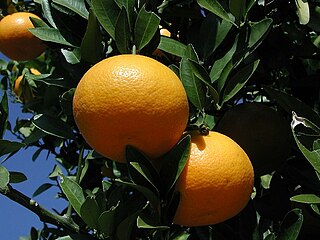 W
WThe iyokan, also known as anadomikan (穴門みかん) and Gokaku no Iyokan, is a Japanese citrus fruit, similar in appearance to a mandarin orange, arising from a cross between the Dancy tangerine and another mandarin variety, the kaikoukan. It is the second most widely produced citrus fruit in Japan after the satsuma mandarin.
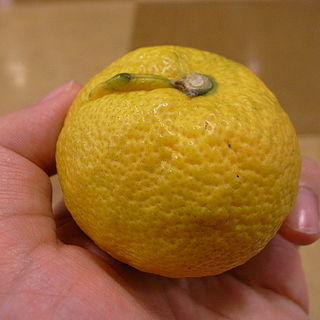 W
WJabara (ja:ジャバラ) or Citrus jabara (Tanaka) refers to a plant and fruit that is among the Japanese citrus.
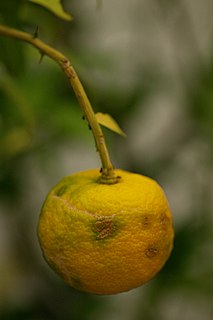 W
WA number of citrus fruits are grown in or strongly associated with Japan. Many of these fruits are of Chinese origin, but have been modified or specially bred for cultivation in Japan.
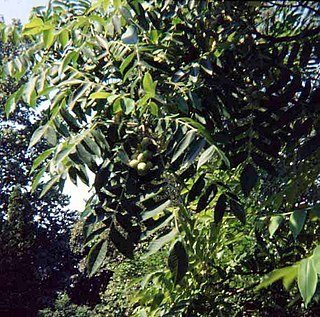 W
WJuglans ailantifolia, the Japanese walnut, is a species of walnut native to Japan and Sakhalin. It is a deciduous tree growing to 20 m (66 ft) tall, rarely 30 m (98 ft), and 40–80 cm stem diameter, with light grey bark. The leaves are pinnate, 50–90 cm long, with 11-17 leaflets, each leaflet 7–16 cm long and 3–5 cm broad. The whole leaf is downy-pubescent, and a somewhat brighter, yellower green than many other tree leaves. The male flowers are inconspicuous yellow-green catkins produced in spring at the same time as the new leaves appear. The female flowers have pink/ red pistils. The fruit is a nut, produced in bunches of 4-10 together; the nut is spherical, 3–5 cm long and broad, surrounded by a green husk before maturity in mid autumn.
 W
WKabosu is a citrus fruit of an evergreen broad-leaf tree in the family Rutaceae. It is popular in Japan, where its juice is used to improve the taste of many dishes, especially cooked fish, sashimi, and hot pot dishes.
 W
WKanpei, also known as Ehime queen splash, is a Citrus cultivar that originated in Japan.
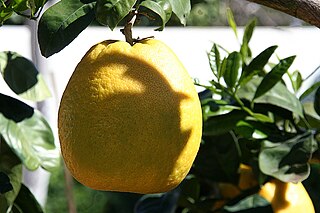 W
WKawachi Bankan, also called Mishokan and Uwa Gold, is a Citrus hybrid cultivated for its edible fruit.
 W
WKiyomi is a Japanese citrus fruit that is a hybrid of a Miyagawa Wase mikan and an orange. The new breed was the first tangor created in Japan in 1949. It was named Kiyomi after the temple Seiken-ji (清見寺) and the lagoon Kiyomi-gata (清見潟) near its experiment station in Shizuoka city and registered as "Tangor Nōrin No.1" in 1979.
 W
WKoji orange, also called smooth-fruited orange in English, bingyul in Korean, 光橘, 柑 子, and 日本土柑 in Chinese, and コウジ (Kōji) in Japanese, is a Citrus species native to Japan.
 W
WThe komikan is a type of mandarin orange grown in Japan. "Ko" means "little", and "mikan" a type of citrus cultivar; komikans are unusually small. It is almost the same as the Kishumikan.
 W
WKoshu is a white wine grape variety that has been grown primarily in the Koshu Valley in Yamanashi Prefecture, Japan. Though long thought to be of exclusively European origin, it is now known to be a hybrid of Europe's Vitis vinifera and one or more East Asian Vitis species. The name “Koshu” is a former name for Yamanashi and the present-day name of the main town in the valley where the majority of Koshu grapes are grown.
 W
WKyoho grapes are a Concord-like cross popular in East Asia. The fruits are blackish-purple, or almost black, with large seeds and juicy flesh with high sugar content and mild acidity. The variety was first produced by a Japanese viniculturist, Yasushi Ohinoue in the 1930s and 1940s, by crossing Ishiharawase and Centennial grape varieties. Like the Concord, Kyoho is a slip-skin variety, meaning that the skin is easily separated from the fruit. The seeds are bitter and the skin is not traditionally eaten. The grape maintains some of the flavor qualities of the Concord, known to consumers from the flavor of most grape jellies and Concord grape juice.
 W
WŌgonkan or Ki-mikan are the common names for a small sized variety of Japanese citrus, whose rind is of a characteristic "golden" bright yellow color.
 W
WThe Oriental melon, also known as the Korean melon, is a group of Cucumis melo cultivars that is cultivated in East Asia. Phylogenetic studies tracing the genetic lineage of the plant suggest that it may have originated in eastern India, having then spread to China over the Silk Road, from which it was introduced to Korea and Japan. Its flavour has been described as a cross between a honeydew melon and a cucumber. It is noticeably less sweet than Western varieties of melon, and consists of about 90% water. The fruits are commonly eaten fresh; with its thin rind and small seeds, the melon can be eaten whole.
 W
WPione is a large-berried, purple skinned, table and rosé wine grape variety that has been grown in Japan since 1957.
 W
WPonkan ; Citrus poonensis; "Chinese Honey Orange") is a high-yield sweet Citrus cultivar with large fruits in the size of an orange. It is a citrus hybrid, though it was once thought to be a pure mandarin.
 W
WPrunus mume is an East Asian and Southeast Asian tree species classified in the Armeniaca section of the genus Prunus subgenus Prunus. Its common names include Chinese plum, Japanese plum, and Japanese apricot. The flower, long a beloved subject in the traditional painting and poetry of East Asia and Vietnam, is usually called plum blossom. This distinct tree species is related to both the plum and apricot trees. Although generally referred to as a plum in English, it is more closely related to the apricot. In East Asian cuisine and Vietnamese cuisine (Vietnamese), the fruit of the tree is used in juices, as a flavouring for alcohol, as a pickle and in sauces. It is also used in traditional medicine.
 W
WPrunus salicina, commonly called the Japanese plum or Chinese plum, is a small deciduous tree native to China. It is now also grown in fruit orchards in Vietnam, Korea, Japan, the United States, and Australia.
 W
WReikou is a cultivar of tangor. It is a citrus hybrid of a hybrid of Kiyomi and Encore and Murcott tangor.
 W
WRuby Roman is a variety of table grape grown and marketed entirely in Ishikawa Prefecture, Japan. It is red in color and about the size of a ping-pong ball. The first Ruby Roman grapes went on sale in August 2008 for 100,000 Japanese yen (US$910) per 700-gram bunch, or $26 per grape. They are said to be the most expensive variety of grapes. In July 2016, a single bunch of Ruby Roman grapes, containing 26 grapes at a weight of about 700 grams, sold for 1.1 million yen in the year's first auction at a wholesale market in Kanazawa.
 W
WSanbokan is a Japanese citrus fruit of the Wakayama prefecture similar to a mandarin orange, easily distinguished by its pronounced basal nipple.
 W
WCitrus unshiu is a semi-seedless and easy-peeling citrus species, also known as miyagawa mandrin, unshu mikan, cold hardy mandarin, satsuma mandarin, satsuma orange, naartjie, and tangerine. Citrus unshiu was named after Unshu (Wenzhou), a famous production area of mandarin oranges in China, in the late Edo period of Japan. It is said to have originated in either Japan or China, and because of its name, it is often described as originating in China; however, due to multiple genetic studies conducted in the 2010s, the theory that the maternal species of Citrus unshiu was Kishu and the paternal species was Kunenbo and that it was created in the Satsuma province in Japan became more credible. During the Edo period, Kishu was the most popular because there was a popular superstition that eating Citrus unshiu (Satsuma) without seeds made people more prone to infertility. Citrus unshiu became popular in Japan after the modernization started in the Meiji period. It was introduced to the West from the Satsuma region of Japan in 1878.
 W
WSetoka is a seedless and highly sweet Japanese citrus fruit that is a tangor, a hybrid of the Murcott tangor with "Kuchinotsu No. 37", which in turn is a hybrid of the Kiyomi tangor and a King tangor/Willowleaf mandarin cross, "Encore No. 2". It was registered as "Tangor Nōrin No.8" in 1998 and as "Variety registration No.9398" under the Plant Variety Protection and Seed Act in 2001. It weighs 200–280 g (7.1–9.9 oz) and has an oblate shape. The rind is thin and easily peelable. Its flavor is pleasant, aromatic, and similar to the Murcott. The fruit ripens in February. Setoka are very sweet. Sugar level is 12–13 °Bx and citric acid is low (0.8–1.0%).
 W
WCitrus depressa, in English sometimes called shiikuwasha, shequasar, Taiwan tangerine, Okinawa lime, flat lemon, hirami lemon, or thin-skinned flat lemon, is a small, green citrus fruit rich in flavonoids and native to East Asia.
 W
WShonan Gold (湘南ゴールド) is a hybrid Japanese citrus, with a characteristic "golden" bright yellow color.
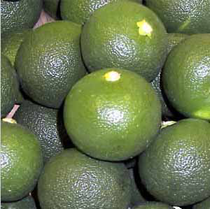 W
WSudachi is a small, round, green citrus fruit of Japanese origin that is a specialty of Tokushima Prefecture in Japan. It is a sour citrus, not eaten as fruit, but used as food flavoring in place of lemon or lime. Genetic analysis shows it to be the product of a cross between a yuzu and another citrus akin to the koji and tachibana orange.
 W
WVaccinium uliginosum is a Eurasian and North American flowering plant in the genus Vaccinium within the heath family.
 W
WVaccinium vitis-idaea, the lingonberry, partridgeberry, mountain cranberry or cowberry, is a small evergreen shrub in the heath family Ericaceae, that bears edible fruit. It is native to boreal forest and Arctic tundra throughout the Northern Hemisphere, from Europe and Asia to North America. Lingonberries are picked in the wild and used to accompany a variety of dishes in Northern Baltoscandia, Russia, Canada and Alaska. Commercial cultivation is undertaken in the U.S. Pacific Northwest and in many other regions of the world.
 W
WThe yūkō (ゆうこう), also written yukou, is a Japanese citrus found in the Nagasaki Prefecture and Saga Prefecture of Japan. Genetic analysis has shown it to be a cross between the kishumikan and koji, a part-tachibana orange hybrid native to Japan.
 W
WYuzu is a citrus fruit and plant in the family Rutaceae of East Asian origin. Yuzu has been cultivated mainly in East Asia, though recently also in Australia, Spain, Italy and France.